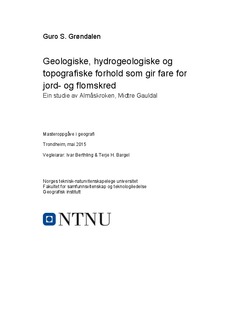| dc.description.abstract | Climate change in Norway is thought to result in increased precipitation as well as more extreme precipitation events. As a result of this, the frequency of rainfall-induced landslides and debris flows are estimated to increase in many parts of the country. This paper examines the setting for a large landslide that occured on August 13th, 2013 in Almåskroken, Midtre Gauldal municipality in Norway. Through field observations, analysis of hydrological data and digital terrain analysis, release mechanisms for the landslide are determined and the overall slope stability of the study area is discussed. Results from the study indicate that a highly local, intense precipitation event led to the triggering of the landslide, by excess pore water pressures occuring in relation to a convex terrain feature. Findings further indicate that local factors such as soil layering, logging roads and convex terrain features lead to a susceptibility for pore pressure build-ups, and consequently a reduction of slope stability during extreme precipitation events. | nb_NO |
